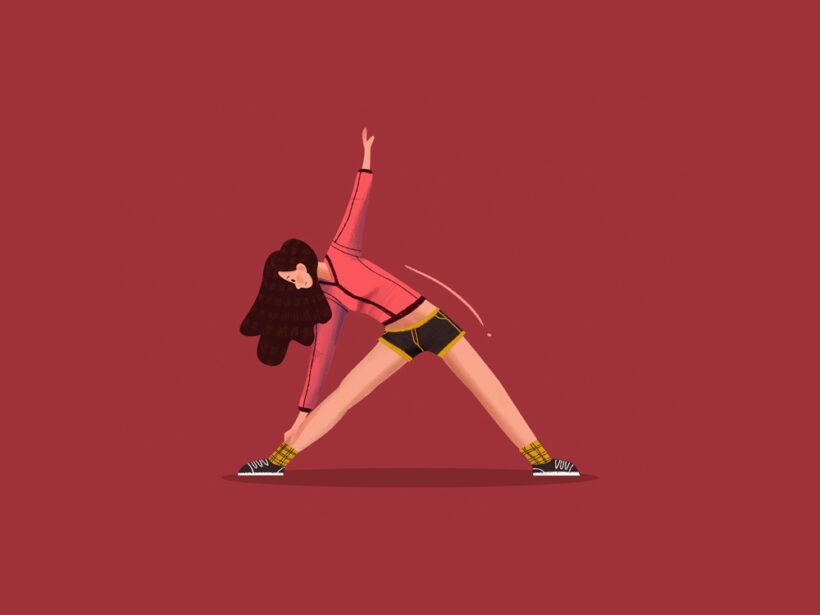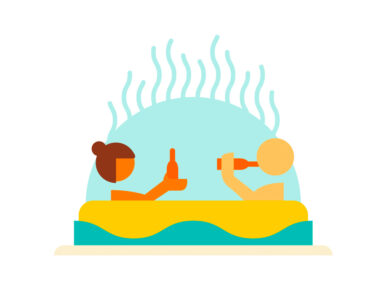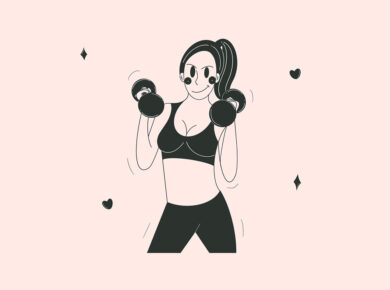Does stretching burn calories? So glad you asked! Well, the answer is complicated.
Studies have shown that light to moderate-intensity aerobic exercise will help you burn more calories.
Some people say that stretching does not count as exercise because it’s mostly static (also sometimes called isometric).
These people are not wrong; while some types of stretching could provide a low-intensity workout, others might be too easy or even relaxing to really qualify.
Different kinds of stretching also work different muscles and systems in your body.
But the question is does it really help your blast off those extra pounds?
Let’s find out.
Why Does the Question Matter?
As you are probably aware, there are plenty of exercise positions that can help you develop your body to look good.
Maybe you want to have that 6-pack abs, maybe you just want to lose some weight, or maybe you just want to be fit.
Let’s say for example that you’re training for a marathon. What is the best way to train?
Well, if it were me I’d check out the resources around me and follow what professional athletes think is good training.
However, let’s say you have a personal goal of being able to do 10 pull-ups.
Well, I can tell you right now that doing pull-ups every day will help you achieve your goal.
Let’s say that your goal is to be able to run three miles without stopping.
To achieve this, the solution is simple: just go outside and run three miles every day.
If you want to be stronger, lift more weights. Do you want to be fitter? Do more cardio.
Maybe you want to lose weight.
Obviously, the best way to lose weight is engaging in rigorous exercise routines that can stimulate your body into burning fat for energy, while also keeping your diet in order.
So the question does stretching burn calories is actually a legitimate one, because if your goal is to be lean, then it matters how you achieve that goal.
You might say to yourself “I have plenty of free time so I’ll just do some light stretch every day”.
It starts off as an innocent thought but if you don’t have a plan in place, you might just end up wasting time.
What is Stretching?
Stretching has been done by humans for a long time in various forms.
It is a form of exercise that involves the voluntary elongation of muscles, tendons and ligaments.
When done properly it can result in increased range-of-motion and functional flexibility, improved posture and reduced chance of injury from overuse or sudden trauma.
When done improperly, stretching can result in injury.
Types of Stretching
As previously mentioned, different kinds of stretches work different muscles and systems in your body.
A good way to categorize stretches is by their effect on the position of the skeletal joints. There are three types:
1) Passive – these occur when a person actively relaxes into a stretch that is provided by another person or an object such as a rubber band or a doorjamb.
2) Abdominal or Postural – these occur when a person is in the resting position with the knees extended and the feet flat on the floor.
3) Dynamic – these occur when a person actively moves a joint through its full range of motion.
As you probably noticed, I have referred to both passive and dynamic stretches as being able to help you with your weight-loss goals.
Benefits of Stretching
- Increased blood flow
- Improved range-of-motion:
- Increased flexibility:
- Improved posture:
- Increased circulation to joints and soft tissues
- Reduced muscle tension
- Improved athletic performance
- Alleviation of muscle tightness
- Enhanced athletic performance.
- Improved posture and balance
- Relaxation and stress reduction
- Decrease in muscle soreness, while improving flexibility and strength
What Does Science Say | Are Stretching & Weight Loss Linked?
Intensity, duration, and frequency of stretching have been researched in a few studies.
As I mentioned before, these studies have shown that light to moderate-intensity aerobic exercise will help you burn more calories.
Moderate exercise such as brisk walking can help you lose weight.
Light to moderate aerobic activity also helps you burn more calories than light activity.
You should be aware that overweight adults who performed at least 150 minutes of moderate-intensity aerobic activity per week were more likely to lose weight.
This is because increasing your heart rate for a long time can help you burn more calories.
Studies have shown that individuals who perform moderate-intensity aerobic exercise daily do not gain weight.
Studies have shown that patients who performed moderate-intensity aerobic exercise daily were able to control their weight.
Aerobic activity is defined as any activity in which you can easily carry on a conversation, such as walking, biking, and even swimming.
Studies have shown that weight loss does not result from a drop in weekly caloric intake.
This is because people tend to compensate for a drop in calories by eating more at a later time.
Aerobic activity can help you lose weight, but diet is equally important.
In one study, obese patients were put on a diet and either did or did not do aerobic exercise three times per week.
The diet consisted of 1000 calories per day. The two groups lost the same amount of weight over a year, but the aerobic exercise group lost more body fat.
Therefore, you will benefit most if you combine aerobic activity with a reduced-calorie diet.
Try to reduce your caloric intake by about 400 calories per day. This way, you can have a caloric deficit of 350 calories.
In another study, obese patients were put on a diet and either did or did not do aerobic exercise at the same time.
The two groups lost similar amounts of weight over six months, but the group that exercised also lost more body fat.
How Can You Tell if You Are Burning Calories from Stretching or from Exercise?
The calories you burn doing stretching exercises are much less than the calories you burn doing aerobic exercise.
You should be able to feel the difference between the exercise.
If you can tell that your body is burning calories from stretch instead of exercise, it’s time for an update.
If you are using your legs or core muscles to hold your body in a position like jogging or hula-hooping, then you are burning fewer calories than if you were to use aerobic activity (i.e., running).
If you are exercising at the same time as you stretch, your caloric burn from exercise may go up because the stretch will be easier to do in a fasted state.
There may be a limit to how much you burn in a day doing aerobic exercise that doesn’t have anaerobic components.
In other words, your body’s capacity to burn calories from aerobic activity is limited.
If you are doing aerobic exercise while you stretch, then you can burn calories from stretching exercises greater than what you burn from aerobic exercise alone.
If your stretch includes resistive work such as strength training or balancing on unstable surfaces, then your caloric burn from stretching exercises may be less than the caloric burn from exercising.
If you are doing exercise that burns calories from muscle glycogen, then you will get a greater caloric burn from aerobic activity than from stretching exercises that do not burn calories from muscle glycogen.
You can use your heart rate monitor to tell the difference between weight-loss and weight-maintenance stretches.
Even in a fasted state, if you can see your heart rate go up, it is more likely due to aerobic exercise and not stretching.
Is it Possible that You Burn Calories from Stretching if You are Aerobic Training?
The aerobic training protocol that involves light to moderate intensity pumping action will burn calories mainly because of the pumping action.
The pumping action is due to the anaerobic component of aerobic training. However, aerobic training also burns calories from stretching exercises.
Therefore, while aerobic training can elevate your caloric burn while you stretch, it is not likely greater than the calories you burn while you are doing aerobic exercise.
In other words, it is not possible to burn more calories from aerobic training if your stretch includes aerobic exercise.
Stretching Alone Won’t Make You Lose Weight
If your only goal is to lose weight, then you should focus more on aerobic exercise than stretching exercises.
Stretching alone will not make you lose weight.
You should do aerobic exercise first because these exercises burn the most calories out of any other exercises.
Next, you can do stretching exercises before or after your aerobic training sessions.
The best time to stretch is right after your workout because this will make it easier to move the next day.
You should use this time to warm up or cool down as desired.
Do You Need to Stretch Before Aerobic Exercise?
Most studies have found that stretching will improve your aerobic exercise performance.
This reflects the result of stretching on body tissues, which are more elastic.
However, most studies have also found that intensity is directly related to how much performance you gain from stretching.
In other words, the most performance benefit comes when you do anaerobic rather than aerobic activity.
As a result, it is not necessary to do specific pre-workout stretches before aerobic training just for performance gains.
If you are doing a structured aerobic training program, a regular stretching routine will be part of your routine.
Many people think that you need to stretch before aerobic exercise or before a workout.
They tend to do their stretching later in the day.
In addition, they think they should stretch more often if they want results faster.
These people usually do not know that the best time is right after they have been exercising because most studies have found that this is when most benefit from the stretching exercises comes from.
Does Stretching Burn Calories – The Answer Is Complicated
The answer to this question is complicated and involves both nutrition and exercise, as well as stretching and stretching exercises.
The short answer is yes, but not as much as you might think.
This is because people’s bodies are designed to burn calories from muscular contractions.
Some people think that stretching and exercise cause little or no calorie burning (which is not true).
Here’s how it works: When you stretch and contract the muscles in your body, it creates heat.
When you work out, your body is trying to keep the temperature of your muscle tissue warm.
What happens when you stretch is that the increased temperature of your muscles forces more calories (calories from food) to go into the production of energy by burning carbohydrates for fuel.
If the muscles are warm enough, then your body will burn fat for fuel.
The more fat you have, the more calories you will burn.
The benefit of stretching is that you are helping the body to become more flexible and agile.
As a result, your muscles are able to contract with greater ease and less trauma.
This allows for a better range of motion, improved performance, increased flexibility and increased agility.
This all helps you to stay healthy and active throughout your life.
Final Thought On “Does Stretching Burn Calories”
So, by now I hope I’ve cleared the air out of some misconceptions about stretching.
Stretching is good for you, however, it’s not a miracle worker that will lead to weight loss.
You need to use it in conjunction with exercise. If you are doing aerobic exercise, then it is important to stretch after exercise along with any warm-ups or cool-downs before/after your aerobic exercise session.
The best time to stretch is right after you have been exercising since most studies show the best results are seen at this time.
In order to get the most benefits from stretching it is also good to stretch before aerobic exercises.
Warm-up and cool-down stretches have the same benefits as the stretching techniques used during aerobic exercise.
These will help warm up and cool down your muscles for a more efficient workout.
Good luck girls!






